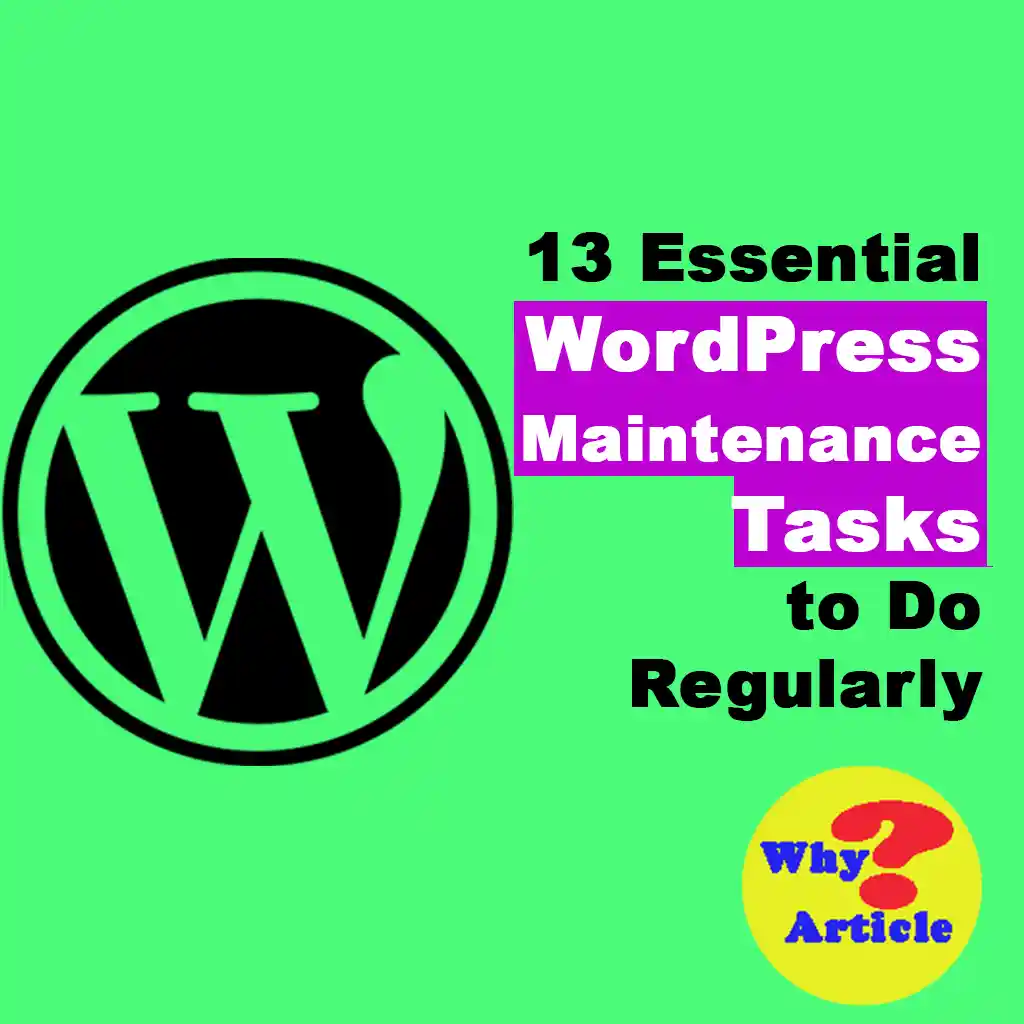Ever wondered which crucial maintenance tasks are essential for your WordPress site? You’re not alone! Many of our readers ask this same question.
The good news? Regular WordPress maintenance tasks are quick and straightforward. Plus, they can significantly boost your site’s security, speed and overall performance.
In this guide, we’ll walk you through the most vital WordPress maintenance tasks you should do regularly and how to carry each one out effectively.
Why and When Should You Perform WordPress Maintenance?
Your WordPress site is a complex system with multiple components. These include your WordPress hosting, the core WordPress software and your plugins and themes.
Add your unique content—text, images and more—and you’ve got a site that captivates your visitors.
Often, after launching a blog or website, many owners forget about regular maintenance until something goes wrong.
However, to ensure your site runs smoothly and performs at its best, you need to conduct routine maintenance.
So, how often should you carry out these tasks?
If your site attracts a lot of traffic, you should follow this WordPress maintenance checklist every 3 months at least.
For smaller sites with less traffic, performing these tasks every 6 months will keep things running smoothly.
Let’s dive into the essential WordPress maintenance tasks and how to tackle them effectively.
1. Update All Your WordPress Passwords
Passwords are your primary line of defense against unauthorized access to your website. It’s essential to use strong, unique passwords for all your online accounts to keep them safe.
Even with robust passwords, there’s always a risk they could be compromised without your knowledge.
That’s why WordPress security experts suggest changing your passwords regularly.
This includes updating passwords for your WordPress admin area, FTP or SSH accounts and your WordPress database.
Strong passwords can be tricky to remember, which is why we recommend using password manager apps like 1Password.
These apps securely store and autofill your passwords, so you don’t have to remember them all.
2. Create a Comprehensive Backup of Your Website
Having a backup plugin is essential for maintaining your WordPress site’s security.
There are numerous reliable WordPress backup plugins available, such as Duplicator, UpdraftPlus and BlogVault.
These tools streamline and automate the backup process, making it easier to keep your site safe.
Despite their effectiveness, these backup solutions can occasionally malfunction without your knowledge.
To ensure your website is always protected, it’s important to manually initiate your backup plugin from time to time.
After running the backup, verify that your files are correctly stored in your chosen remote location, whether it’s Dropbox, Google Drive or another service.
3. Check and Update All WordPress Files
WordPress has a built-in feature that manages updates for WordPress core, plugins and themes.
It’s crucial to keep your WordPress version, plugins and themes updated to ensure they work seamlessly and securely.
Sometimes, updates might be missed. For instance, a premium plugin or theme might not check for updates if its license has expired.
To avoid this, head over to the WordPress Updates page and manually check for updates.
Review all your plugins and themes to confirm they are up-to-date. If some aren’t updated, make sure to note why you’ve decided not to update them.
4. Check and Delete Spam Comments
Many website owners use Akismet to fight off spam comments in WordPress. It automatically filters spam from your comment moderation queue.
However, occasionally, Akismet might incorrectly mark a legitimate comment as spam.
It’s a good idea to periodically review your spam comments to ensure no genuine comments are caught in the filter.
After reviewing, you can delete all spam comments from your website.
If you have a large number of spam comments, batch-deleting them in WordPress is the most efficient way to clean up.
While this won’t necessarily boost your site’s performance, it ensures that no legitimate comments are overlooked.
5. Test All Your WordPress Forms
WordPress form builder plugins like WPForms make it easy to create and manage forms on your site.
However, issues with your WordPress hosting or email service provider can sometimes cause these forms to stop sending emails.
It’s important to test all forms on your website to ensure they’re functioning correctly.
For best results, we recommend using the WP Mail SMTP plugin. It includes email logging and will notify you if an email fails to send.
6. Optimize Your WordPress Database
Your WordPress database is where all your site’s data is stored, including your posts, comments, users and settings.
Over time, it can collect unnecessary data that bloats your backups, making them larger and harder to manage. This can affect how quickly you can upload, download or restore backups.
To keep your WordPress database in top shape, you should regularly clean up excess data, defragment tables and enhance overall performance.
7. Run Performance Tests
It’s common for WordPress users to optimize their site’s performance when they first launch, but then they may forget about it.
As you add new content, plugins and even change themes, these changes can impact your site’s speed and efficiency.
A fast-loading website is crucial for both user satisfaction and SEO rankings. That’s why it’s important to perform regular performance checks.
When testing, don’t just focus on your homepage. Make sure to review your most popular posts and key pages as well.
8. Find and Fix 404 Errors
When users try to access a page that doesn’t exist on your site, they’ll encounter a 404 error page.
While some 404 errors are harmless—such as those caused by typos—others indicate that a page is no longer available, which can frustrate visitors and hurt their experience on your site.
9. Find and Fix Broken Links
As your website grows, you might find that some of the external links in your older posts no longer work.
Websites can move or shut down, causing broken links. Additionally, you might have internal issues like broken images or misspelled links.
Broken links can harm your site’s user engagement and overall experience.
It’s important to regularly check for and fix these issues as part of your WordPress maintenance routine.
10. Conduct a Comprehensive Content and SEO Review
One essential task for maintaining your website is to perform a thorough content and SEO review.
This is where data from tools like Google Search Console and Google Analytics becomes crucial.
Google Analytics provides insights into where your visitors are coming from and what actions they’re taking on your site.
This information helps you pinpoint content that attracts a lot of traffic but has a low conversion rate.
Meanwhile, Google Search Console’s Performance page helps you identify which search keywords bring your site up in search results.
You can use this tool to find keywords where you have the potential to rank higher by updating your content.
If you’re using All in One SEO plugin, you can designate specific keywords as focus keyphrases. This tool will then provide you with a True SEO Score along with tailored optimization tips.
Even if your SEO score looks great, there’s always room for improvement.
Consider adding fresh information, incorporating images and linking to your content from other parts of your site.
11. Optimize Images on Your WordPress Site
Images can slow down your website because they often take longer to load than text. This can affect your page load time and overall user experience.
During a performance check, you might find that some of your images are too large and causing delays.
It’s easy to overlook oversized images, especially in older or less-trafficked posts.
On a multi-author WordPress site, not all authors may be mindful of optimizing image sizes.
To keep your site running smoothly, regularly review your images and media library.
Identify any large images and resize them to improve your page load times.
This small step can make a big difference in your site’s performance and user satisfaction.
12. Review WordPress Security Logs
Often, WordPress users only become aware of security issues when their site slows down or their search rankings drop.
To stay ahead of potential problems, it’s essential to proactively monitor your site’s security.
Aside from changing passwords and creating manual backups, reviewing your site’s access and error logs is crucial. These logs can reveal unusual activity that might indicate a security threat.
Consider adding a security audit plugin to your WordPress site. Plugins like Sucuri and MalCare are excellent choices.
They provide robust website firewalls to protect against common threats and help keep your site secure from potential attacks.
13. Troubleshoot Maintenance Tasks
Maintaining a WordPress website is usually a straightforward process and won’t disrupt its usual operations.
However, some tasks might temporarily slow down your site, such as checking for broken links or using an image optimizer plugin.
If you have a staging site, it’s a great idea to do your maintenance work there before making changes live. This way, you can avoid any negative impact on your live site.
For those who don’t have a staging site, be prepared for potential slowdowns or unexpected glitches.
To minimize disruption, consider putting your WordPress site in maintenance mode or scheduling these tasks during times of low traffic.
We hope this guide has helped you understand the essential WordPress maintenance tasks to keep your site running smoothly.




